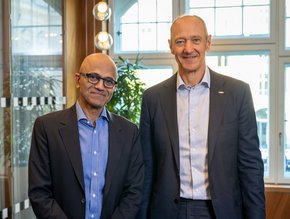Feature: How thinking 'intuitively' can help solve the UK's productivity woes

David Goff, Head of Enterprise Networks, Cisco UK and Ireland, how thinking ‘intuitively’ can help solve the UK’s productivity woes.
The UK is recognisably suffering from a productivity problem.
Last year, the Office for National Statistics (ONS) found that since the 2008 recession, economic growth has only been achieved by increasing the number of weekly hours employees work. Ten years is a long time to allow a problem to remain unsolved, especially when it leaves staff feeling exhausted. If one thing is clear, it is that UK businesses need more support to compete with an increasingly globalised marketplace. The current status quo simply is not sustainable for them in the long term. It therefore came as no surprise to see Chancellor Phillip Hammond again make tackling the UK’s long-standing productivity challenge a high priority for the UK Government.
See also:
- Profile: Accenture's new Netherlands Managing Director, Irine Gaasbeek
- Airbus' innovative data platform Skywise takes off, two major deals signed
- Business Chief, Europe edition - Read our March issue here
Similar to last year’s Autumn Budget announcement, Phillip Hammond focused the Spring Statement on the UK’s technology landscape and the role it can play with supporting British businesses. The Chancellor underpinned how the UK must unleash innovations, embrace new technologies and most importantly, alleviate long-held productivity pain. Whilst many would have thought that this would be comforting to hear, turning this optimistic rhetoric into a realistic industrial strategy is easier said than done. With so many apparent routes to success available to businesses, it can be very intimidating to know where to start with investing into the technology that promises to make the difference they crave for their staff.
Investment in emerging technologies
The last few years has given rise to many innovative technology trends – such as artificial intelligence, machine-learning, the internet of things (IoT) and blockchain to name just a few. Business leaders have subsequently been left feeling spoilt for choice, with trying to select and implement the right tools to enhance workplace productivity all feeling hugely daunting. But let’s be clear, they are going to spend. Gartner recently predicted that the lure of these technologies will drive global IT spending to reach $3.7 Trillion during 2018, increasing 4.5% from the previous year, due to a recognition that these technologies could potentially recover up to 6.2 billion hours of worker productivity.
This poses several questions: what technologies will companies decide to spend their money on to future-proof their business, increase value and maximise productivity? And what should they spend their money on?
Intent-based networking - pivotal to future innovation
Intent-based networking is the one trend to keep an eye on. There are now more connected devices globally than there are people, each containing different information, knowledge and capabilities. To effectively manage and leverage such an array of devices in the workplace, an intent-based network is essential.
Intent-based networks can continuously learn and adapt, gathering new insights and predicting outcomes before they occur. Users interact with the network by making a request, the network then intuitively calculates the best option for solving that request and automates the necessary action without prompt.
This all serves to eradicate the mundane tasks employees have all come to dread over time, offering a new level of automation that can solve the common complexities we so often see draw frustrated breath and drooping shoulders in the workplace.
Shifting business approaches
Cisco is at the vanguard of innovation within the intent-based networking space having developed what we call the ‘Network Intuitive’. Cisco’s Network Intuitive recalibrates processes and enhances productivity by empowering businesses with a ‘humanised’ network, one which thinks for itself, predicts the next steps and actions them accordingly.
Shaping workplace ecosystems
The network intuitive offers an insight into everything that’s connected to the workplace ecosystem. It is capable of applying context, such as prioritising and solving network traffic needs, or establishing devices that might be threatening the network (identifying and automating how best to deal with these threats to minimise disruption). This technology can adapt to networking performance and change in real-time to match a preferred status by users, automating the necessary actions so they are no longer a constant worry for the IT team usually responsible.
High-profile organisations like NASA, DB Systel GmbH, Jade University of Applied Sciences and Royal Caribbean Cruises have all already adopted the Network Intuitive and are reaping the rewards, resolving to prepare themselves now for this next stage of workplace transformation.
Looking to the future
Intent-based networks will not be the only technology which businesses will or should invest in over years to come. However, as the number of connected devices grows and we continue to see innovation prosper, it is highly likely that technologies in IoT, machine-learning and blockchain will rely on these networks to maximise productivity.
There’s no questioning the UK’s productivity woes, but as we enter the fourth industrial revolution we are seeing new technologies emerge, capable of transforming how we operate and which can enhance efficiency across multiple disciplines. Ultimately, decisions surrounding investment lie with business leaders, but if a business is to prosper in this digital age it must be willing to adopt technology that can understand their intent, and subsequently act upon it.






